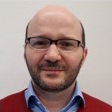Quantum Sensors and Sensing Technology
A special issue of Sensors (ISSN 1424-8220). This special issue belongs to the section "Optical Sensors".
Deadline for manuscript submissions: closed (20 March 2025) | Viewed by 20669
Special Issue Editor
Special Issue Information
Dear Colleagues,
Quantum sensing is based on taking advantage of quantum features to increase the sensitivity of the measurement of a physical quantity. The quantum features exploited are usually quantum superposition, entanglement, and quantum correlations. The physical quantities measured are electric and magnetic field, temperature, and pressure. In addition, imaging resolution can be enhanced by taking advantage of quantum correlations.
Quantum sensing has rapidly developed in the last few years in the broader context of emerging quantum technologies. Quantum effects, such as entanglement, move from being only theoretical or reserved, to specific challenging experiments intended to be the base of recent technological improvements.
This Special Issue aims to gather research and review articles on recent advances, technologies, solutions, applications, and new challenges in the field of quantum sensing.
Potential topics include, but are not limited to:
- Quantum sensing with photons.
- Quantum sensing with nitrogen-vacancy centers.
- Quantum sensing with flux quits.
- Quantum sensing with trapped ions.
- Portable sensors.
Dr. Ettore Bernardi
Guest Editor
Manuscript Submission Information
Manuscripts should be submitted online at www.mdpi.com by registering and logging in to this website. Once you are registered, click here to go to the submission form. Manuscripts can be submitted until the deadline. All submissions that pass pre-check are peer-reviewed. Accepted papers will be published continuously in the journal (as soon as accepted) and will be listed together on the special issue website. Research articles, review articles as well as short communications are invited. For planned papers, a title and short abstract (about 250 words) can be sent to the Editorial Office for assessment.
Submitted manuscripts should not have been published previously, nor be under consideration for publication elsewhere (except conference proceedings papers). All manuscripts are thoroughly refereed through a single-blind peer-review process. A guide for authors and other relevant information for submission of manuscripts is available on the Instructions for Authors page. Sensors is an international peer-reviewed open access semimonthly journal published by MDPI.
Please visit the Instructions for Authors page before submitting a manuscript. The Article Processing Charge (APC) for publication in this open access journal is 2600 CHF (Swiss Francs). Submitted papers should be well formatted and use good English. Authors may use MDPI's English editing service prior to publication or during author revisions.
Keywords
- lab-on-a-chip
- quantum superposition
- entanglement
- quantum correlation
- Heisenberg limit
- sub-shot noise
Benefits of Publishing in a Special Issue
- Ease of navigation: Grouping papers by topic helps scholars navigate broad scope journals more efficiently.
- Greater discoverability: Special Issues support the reach and impact of scientific research. Articles in Special Issues are more discoverable and cited more frequently.
- Expansion of research network: Special Issues facilitate connections among authors, fostering scientific collaborations.
- External promotion: Articles in Special Issues are often promoted through the journal's social media, increasing their visibility.
- Reprint: MDPI Books provides the opportunity to republish successful Special Issues in book format, both online and in print.
Further information on MDPI's Special Issue policies can be found here.






